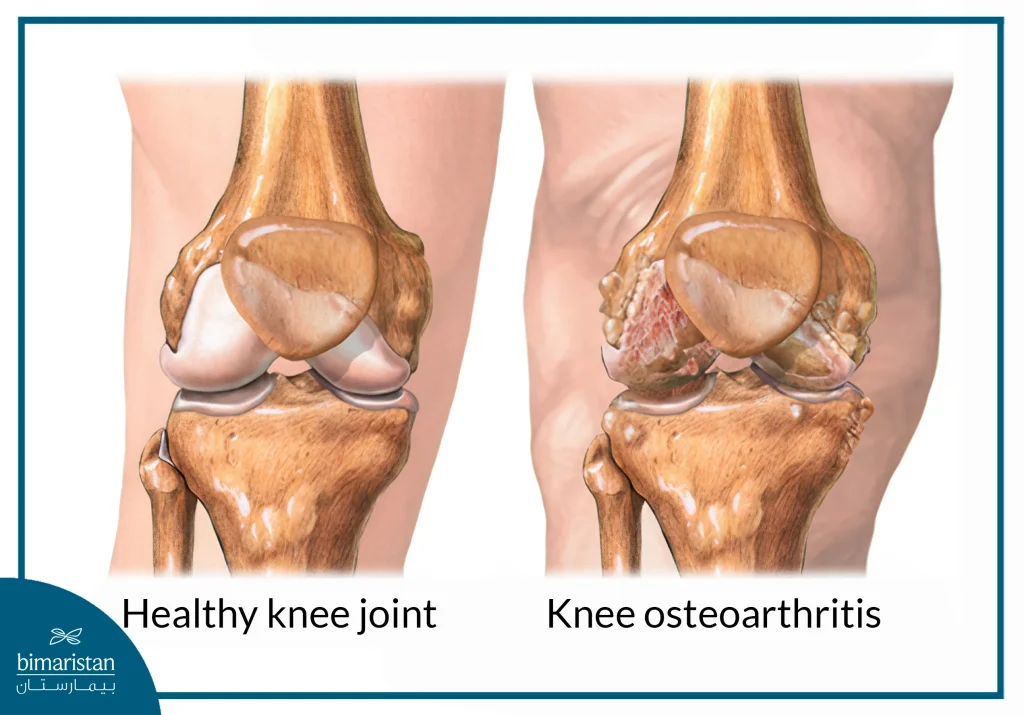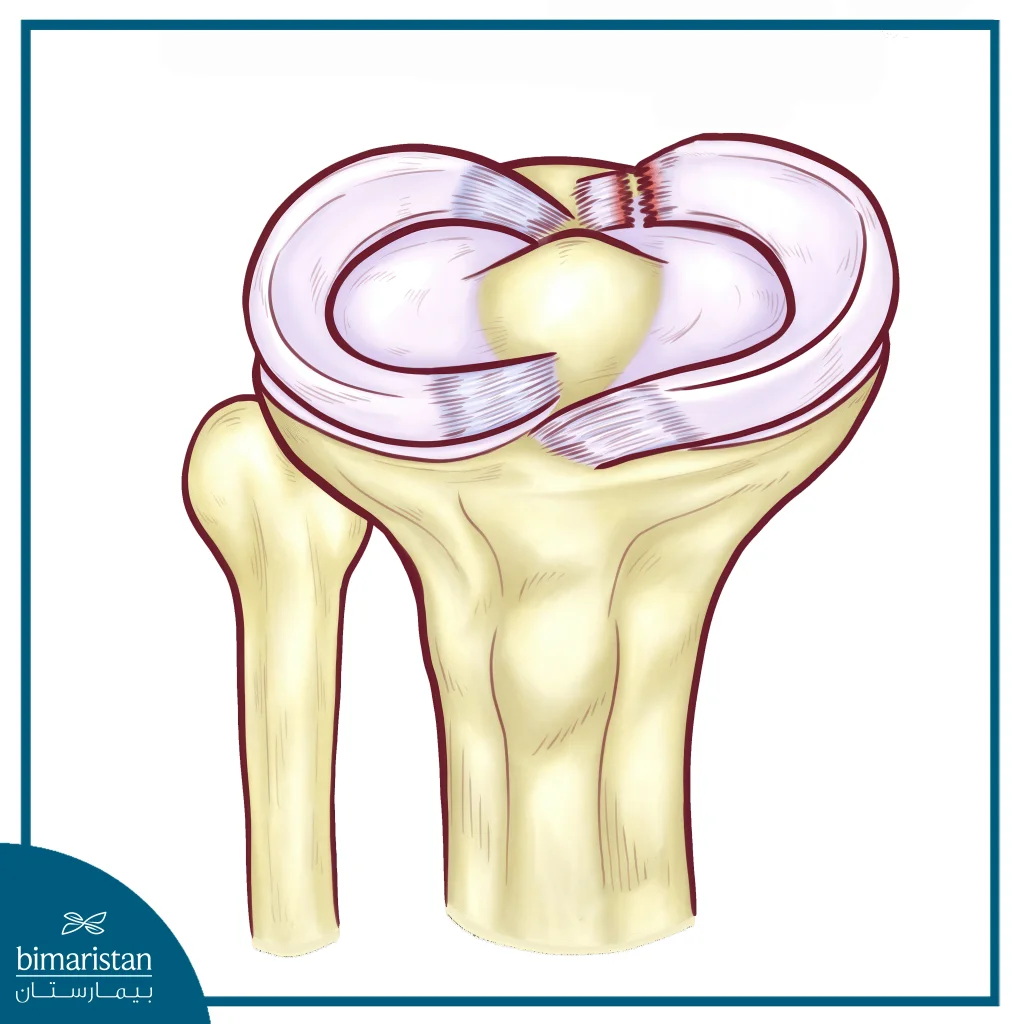Many patients complain of knee pain, and two common diagnoses may come to mind: knee stiffness and torn cartilage. In this article, we explain knee osteoarthritis vs meniscus tear in terms of symptoms, causes, and treatment methods, to help you understand the correct diagnosis.
What is knee osteoarthritis?
Knee osteoarthritis is a condition that occurs when the cartilage in the knee joint wears out, causing the bones to rub together, as this friction causes pain and swelling in the knee, and leads to stiffness in the joint. Knee osteoarthritis is a degenerative joint disease resulting from wear and tear over time and is a very common condition. The knee is one of the most vulnerable joints due to the pressure and stress it bears throughout life.
Knee osteoarthritis is a chronic condition that gradually worsens over time, and there is no definitive cure. However, there are several treatment options that help slow the progression of the disease and alleviate symptoms, but knee pain often worsens over time and can eventually lead to disability.
Causes of knee osteoarthritis
The causes of knee osteoarthritis vary due to multiple factors, including those related to the patient’s health, age, and genetics:
- Age: Since joint stiffness is usually caused by wear and tear, age is the most common cause of knee stiffness. With age, the ability of cells to regenerate themselves becomes slower, leading to cartilage erosion.
- Weight: Excess weight increases the pressure on the joint that bears the weight of the body.
- Genetic factors: Rheumatoid arthritis can run in families due to certain genetic connective tissue diseases, such as Ehler-Danlos syndrome, which tend to develop arthritis faster than others, and abnormalities in the shape of the bones surrounding the knee joint can also be a cause.
- Gender: Women age 50 and older are more likely to develop knee joint roughness than men.
- Sports: Athletes who engage in activities that strain the knee, such as long-distance running, are more likely to develop knee stiffness, depending on the intensity and frequency of the exercise, and the presence of previous knee injuries.
Symptoms of knee osteoarthritis
Symptoms of knee osteoarthritis develop gradually and worsen over time, and symptoms include:
- You may feel pain during or after the movement
- The joint may become stiff, especially upon waking up or after periods of inactivity
- Friction sound when using the joint
- The knee joint loses its flexibility, and the patient may not be able to move the joint within its full range of motion
- Bone spurs may form around the affected joint and feel like hard lumps under the skin
- Knee swelling due to inflammation of the soft tissues surrounding the joint

Secondly: What is a meniscus tear?
Each knee joint contains two C-shaped cartilages that act as a cushion between the shin bone (tibia) and the femur, and this cartilage is called the meniscus, and a meniscus tear may occur as a result of a strong trauma or sudden twisting or rotation of the knee, and with age, the cartilage wears out and becomes weaker, making it more prone to tearing, in addition to arthritis may cause a tear in the meniscus.
Symptoms of a meniscus tear
The symptoms of ameniscus tear are varied and include:
- Sharp pain and swelling
- Difficulty bending the knee
- Swelling or stiffness in the joint
- Feeling that the knee is stuck or doesn’t move freely
- Feeling that the knee is unstable or may collapse when standing or walking

Knee osteoarthritis vs Meniscus tear
The difference between knee osteoarthritis vs meniscus tear varies in terms of causes, target age group, symptoms, and diagnostic methods.
Knee osteoarthritis vs Meniscus tear in terms of causes
Knee osteoarthritis is often caused by the gradual erosion of cartilage over time and is a chronic condition, where secondary factors such as injuries or excessive pressure on the knee contribute to the acceleration of knee roughness, as for the meniscus tear, it occurs as a result of a sudden movement that involves twisting the knee while the foot remains fixed on the ground, and this tear often occurs during sports, and in some cases cartilage deterioration due to arthritis leads to a meniscus tear without a direct injury to the knee.
Knee osteoarthritis vs Meniscus tear in terms of the age group affected
Knee osteoarthritis often affects people over the age of 50 and becomes more common with age due to the gradual erosion of cartilage, while meniscus tears affect all age groups but are common in young people and athletes due to acute injuries.
Knee osteoarthritis vs Meniscus tear in terms of symptoms
Morning stiffness in the knee joint and a friction or grinding sound when using the joint are characteristic symptoms of knee stiffness, while sharp pain on movement and a feeling of knee instability or a sense of being stuck are characteristic symptoms of a meniscus tear.
Knee osteoarthritis vs Meniscus tear in terms of diagnostic methods
Knee osteoarthritis is initially diagnosed by a physical examination of the knee, after which the doctor may order some imaging tests such as magnetic resonance imaging (MRI) or computerized tomography (CT), while a meniscus tear is diagnosed through range-of-motion tests such as the McMurray test or Thessaly test, and the doctor may order some imaging tests such as X-rays or magnetic resonance imaging (MRI).
Knee rheumatoid arthritis treatment
Treatments for knee osteoarthritis include lifestyle changes as well as some non-surgical treatments such as:
- Medicines and painkillers
- Cortisone and steroid injections
- Platelet-rich plasma (PRP) injections
- Knee gel injection
- Physiotherapy
In advanced cases and when conservative treatments fail, the patient resorts to surgical treatment, which includes the following:
- Total knee replacement: The entire damaged knee joint is removed and replaced with artificial parts that allow for painless movement.
- Partial knee replacement: In this procedure, one part of the knee joint is removed and replaced with artificial parts. This surgery is performed when the wear and tear is limited.
- Tibial osteotomy: The tibial bone is reshaped by removing a piece of it to relieve pressure on the knee.
Meniscus tear treatment methods
Depending on the size and location of the meniscus tear, it may heal without the need for surgery. Your doctor may recommend a nonsteroidal anti-inflammatory drug (NSAID) such as ibuprofen or aspirin to relieve pain and reduce swelling, and the following should be followed in the days following the injury:
- Rest: In order to avoid putting weight on the injured knee as much as possible.
- Ice cooling: The patient should place an ice pack on the knee for 20 minutes several times a day.
- Compression: By wrapping the knee with a compression band to reduce swelling.
- Lifting: The affected leg should be elevated above the level of the heart to minimize swelling.
The doctor may also recommend working with a physical therapist to strengthen the knee and increase range of motion. If pain and function do not improve with conservative treatment or in the case of large tears, arthroscopic surgery must be used to repair a torn meniscus. The surgeon inserts a small camera and precision instruments through small incisions in the skin, and a partial resection of the torn cartilage is performed. In some cases, the cartilage is sutured without the need for resection.
How do you protect yourself from knee issues?
In order to prevent knee issues, especially knee osteoarthritis and meniscus tears, you should follow a set of rules to ensure a healthy knee, such as:
- Maintain a healthy weight: In order to minimize stress on the knee joint, each extra kilo puts extra pressure on the joint, and helps prevent obesity-related degenerative arthritis.
- Exercises to strengthen the muscles around the knee: Strengthening the thigh muscles (quadriceps femoris and popliteus) provides better joint support, improves stability, and reduces the risk of injury. Exercises include straight leg raises and stretches, as well as sit-ups and sit-downs.
- Avoid sudden movements and twists during sports to prevent acute injuries
In conclusion, distinguishing the difference between knee osteoarthritis vs meniscus tear is essential to determine the most appropriate treatment plan, while consulting an orthopedic doctor and accurate diagnosis using radiographs or MRIs helps to avoid delays in treatment and achieve the best results.
Sources:
- American Academy of Orthopaedic Surgeons. (n.d.). Meniscus tears. Retrieved July 9, 2025
- Mlesen, N., Diamantopoulos, S., & Ebell, M. H. (2020). Meniscal injuries. In StatPearls. StatPearls Publishing. Retrieved July 9, 2025


